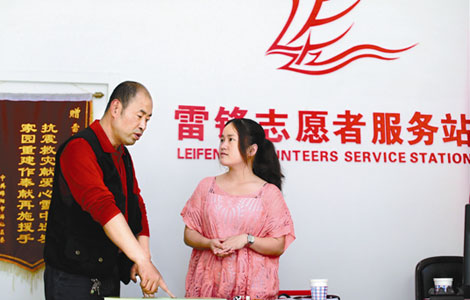Full text: Progress in China's Human Rights in 2012
Updated: 2013-05-14 12:45
(Xinhua)
|
|||||||||||
I. Protection of Human Rights in Economic Construction
China has a population of over 1.3 billion. For such a populous country, it would be impossible to protect the people's rights and interests without first developing the economy to feed and clothe the people. Development is the key to solving all existing problems and facilitating progress of human rights in China. Only by pursuing healthy and sustainable economic development can China consolidate the material foundation for the people's happiness and wellbeing, and protect their rights to subsistence and development. For many years, China has taken economic construction as the central task and, through economic growth, expanded rural and urban employment, increased the residents' income and family property income, provided the people with better food, clothing, housing, transportation and other daily necessities, safeguarded the rights and interests of disadvantaged groups, and effectively protected the citizens' economic rights and interests.
The people's living standards are constantly on the rise. Steady yet relatively rapid economic development has provided the foundation for a better livelihood for the Chinese people. Despite the slowdown of economic growth in the world's major economies and the manifestation of various risks, China's GDP grew by 7.8 percent in 2012 and the rise in the CPI (Consumer Price Index) fell back to 2.6 percent. China's annual grain output in 2012 reached 589.57 million tons, registering the second nine-year consecutive growth since the founding of the People's Republic of China in 1949, topping the 500-million-ton mark for six years in a row. Food is people's paramount necessity. For a country with more than 1.3 billion people, a nine-year consecutive growth in grain output was of particularly significant importance, as it laid a solid foundation for the Chinese people to live a happier and better life. The living and production conditions in rural areas have kept improving. From 2008 to 2012 China built or rebuilt 1.465 million km of rural roads, renovated 10.33 million rural houses in disrepair, solved the problem of drinking water safety for over 300 million rural residents, and provided power to 4.45 million people in areas previously devoid of access to electricity. At the same time, urban and rural residents' income has been growing relatively rapidly. The annual per-capita net income for rural residents reached 7,917 yuan in 2012, up 13.5 percent over the previous year or 10.7 percent in real terms. The annual per-capita disposable income for urban residents was 24,565 yuan, an increase of 12.6 percent or 9.6 percent in real terms year on year. The income growth of urban and rural residents in real terms outpaced the GDP growth, while the income growth of the rural residents in real terms surpassed that of the urban residents. In 2012 the Engel coefficients (i.e., the proportion of food expenditure in the total consumption spending) per rural and urban household were 39.3 percent and 36.2 percent, respectively. By the end of 2012 car ownership had reached 59.89 million, an increase of 20.7 percent over the previous year, among which 53.08 million were private cars, an increase of 22.8 percent. There were 21.5 cars for every 100 urban households, an increase of 15.5 over 2007. The combined number of fixed and mobile phone users reached 1,390.31 million, an increase of 118.96 million over that at the end of the previous year. There were 82.6 mobile phones and 20.7 fixed phones for every 100 people. There were over 564 million Internet users in China, among whom 420 million access the Internet via mobile phones. The Internet penetration rate reached 42.1 percent. The number of domestic tourists in 2012 totaled 2.96 billion, and the number of Chinese citizens making trips abroad reached 83.18 million, up 12.1 percent and 18.4 percent,respectively, over the previous year. Among them, those making trips abroad for private purposes reached 77.06 million, a year-on-year increase of 20.2 percent, accounting for 92.6 percent of the total. Active and steady efforts have been made to promote urbanization. From 2008 to 2012, a total of 84.63 million rural laborers moved to cities and towns, raising the urbanization rate from 45.9 percent to 52.6 percent and effecting a historic change in China's urban-rural structure.
Poverty reduction in rural areas enters a new stage. To constantly improve the living conditions of the impoverished population in rural areas, the Chinese government promulgated the Outline of Development-oriented Poverty Reduction for China's Rural Areas (2011-2020) in 2011, setting forth the general objective of providing adequate food and clothing for poverty-stricken people while ensuring their access to compulsory education, basic medical services and housing by 2020. The state raised the national poverty line substantially to 2,300 yuan per person per year on average (calculated at 2010 constant prices), and by this criterion more low-income people have been included in poverty-reduction programs. In 2011 a total of 122 million people were covered by poverty-reduction programs all over the country, making up 12.7 percent of the rural population. In 2012 the central government spent 299.6 billion yuan on comprehensive poverty-reduction programs, an increase of 31.9 percent over the previous year, of which 33.2 billion yuan was special funds for poverty reduction. The state has launched regional development and poverty-reduction projects in 11 regions, including the Wuling, Liupan and Luoxiao mountainous areas, as well as plans to support the economic and social development of Tibet, Xinjiang, Xinjiang Production and Construction Corps, and the Tibetan-inhabited areas in the provinces of Sichuan, Yunnan, Gansu and Qinghai during the 12th Five-year Plan period (2011-2015). These efforts were aimed at alleviating deep-rooted poverty in these areas. In 2011 the average per-capita annual income for farmers in the counties which are key targets of the government's poverty-reduction work reached 3,985 yuan, an increase of 40.2 percent over 2009, a higher growth rate than that of the average level in China's rural areas. By the end of 2012 the size of the impoverished population in rural China had decreased to 98.99 million according to the new criterion, 23.39 million fewer than that at the end of the previous year. The state formulated the 12th Five-Year Plan for Village-based Development-oriented Poverty Reduction, planning to lift 30,000 impoverished villages in central and western China out of poverty, or 6,000 villages per year, in the five years from 2011 to 2015. At the same time, the living conditions of impoverished disabled people in rural areas have been further improved. In 2012 the State Council issued the Outline of Development-oriented Poverty Reduction for Disabled People in Rural Areas (2011-2020). In the same year the state rendered support to 2.299 million disabled people in poverty in rural China, provided training for 861,000 disabled people in practical skills and helped 132,000 poor families with one or more disabled members to renovate their houses.
People's living standards in poverty-stricken ethnic-minority areas are continuously improving. Based on the actual conditions in ethnic-minority areas, the Chinese government, adhering to the principle of combining assistance from the central government, support from developed regions and self-reliance of the ethnic-minority areas, has formulated a series of preferential policies to promote the ethnic-minority areas' economic growth and improve the living conditions of all ethnic groups. The central government has been continuously increasing transfer payments to ethnic-minority areas. From 2010 to 2012 the total amount of transfer payments to eight ethnic-minority provinces (autonomous regions) reached 2.6055 trillion yuan, up from 24.3 percent to 25.7 percent of the total transfer payments from the central government to local governments. Meanwhile, transfer payments to ethnic-minority autonomous prefectures, counties and border areas have also been increased. The state formulated and promulgated the Plan for Supporting the Development of Ethnic Minority Groups with Fewer Populations (2011-2015), including six ethnic minority groups with populations ranging from 100,000 to 300,000 each in the recipients of assistance, and earmarked special funds to help them develop their economy and improve their production and living conditions. The state also rendered support to the economic and social development of border areas by formulating the Action Plan to Bring Prosperity to Border Areas and the People There (2011-2015). The state adopted policies to increase income for the herdsmen and promote the development of pastoral regions. Marked achievements have been scored in helping ethnic-minority areas and their people get rid of poverty and become relatively well-off. From 2005 to 2010 the number of impoverished people in the eight aforesaid provinces (autonomous regions) decreased from 23.384 million to 13.044 million, and the impoverishment rate dropped from 16.5 percent to 7 percent, nearly 5.5 percentage points faster than the national average impoverishment rate in the same period.
Urban and rural housing conditions are further improved. Since 2009, focusing on the two major themes of "ensuring that all the people enjoy the right to housing" and "obtaining sustainable development of residential areas in the process of urbanization," the Chinese government, while working hard to satisfy the people's diverse demands for housing by promoting market-oriented reform of the urban housing system and developing the commercial housing market, has also listed satisfying the basic housing needs of people in poverty as an important content of the basic public services to be provided by the government and carried out massive affordable housing projects to enhance housing security. The affordable housing projects in China cover the building of affordable housing in urban areas, the rebuilding of shanty areas and rural housing in disrepair, and the building of permanent housing for nomadic herdsmen. From 2008 to 2012 China built more than 18 million affordable suites of housing and rebuilt more than 12 million suites in shanty areas. By the end of 2012 China had provided housing for 31 million urban families, about 12.5 percent of the total urban households. In addition, the government had provided low-rent housing subsidies for nearly five million urban low-income families. At the end of 2012 the per-capita living space in China's urban and rural areas reached 32.9 square meters and 37.1 square meters, respectively, up 2.8 square meters and 5.5 square meters compared with 2007. In order to regulate the expropriation of and compensation for buildings on state-owned land, protect the legitimate rights of the owners of such buildings as well as the public interest, the State Council promulgated and put into effect the Regulations on the Expropriation of and Compensation for Buildings on State-owned Land on January 21, 2011, and simultaneously abolished the Regulations on the Dismantling of Urban Houses promulgated on June 13, 2001.
Proactive efforts are made to boost employment. The steady and sustained economic growth has provided a guarantee for employment. The state implements an active employment policy to guarantee the citizens' right to work. From 2008 to 2012 China invested a total of 197.3 billion yuan in special employment funds, and helped 28 million college graduates and 8.3 million people in urban areas with employment difficulties find jobs. In 2012, against a backdrop of slowing economic growth, 12.66 million new job opportunities were created, 5.52 million laid-off workers were reemployed, and 1.82 million people with employment difficulties found jobs in urban areas of China. At the year's end, the registered urban unemployment rate was 4.1 percent, the same as the previous year. The total number of rural migrant workers was 262.61 million in 2012, up 3.9 percent from the previous year, among whom the number of rural workers employed away from their homes reached 163.36 million and the number of local rural workers reached 99.25 million, representing increases of 3 percent and 5.4 percent over the previous year, respectively. As China encourages farmers to find jobs in or close to their hometowns, 85,000 villages launched recreational agriculture and village tourism, providing jobs for 28 million farmers. In 2012 China helped an additional 329,000 disabled people in urban areas to find jobs, raising the total urban number of employed disabled people to 4.448 million; and in the rural areas, 17.703 million disabled people got stable jobs. In 2011, 22 million people took part in vocational training courses of various types provided by the government. In 2012 the central government appropriated 45.4 billion yuan in special employment funds to help implement policies intended to boost employment. From 2010 to 2012, taking advantage of the training programs of the "Sunlight Project," the Ministry of Agriculture provided agricultural skill training to 9.3 million farmers with 3.3 billion yuan of subsidy funds from the central government.
The basic rights of workers are guaranteed. The state has amended the Labor Contract Law and the Law on the Prevention and Treatment of Occupational Diseases, and formulated the Special Rules on Protection of Female Employees and Interpretations (III) of the Supreme People's Court of Several Issues Concerning the Application of Law in the Trial of Labor Dispute Cases, so as to protect various rights of workers. More trade unions have been established, involving more employees. By the end of September 2012 the number of grassroots trade unions had increased to 2.666 million, covering 6.166 million enterprises and public institutions, up 34.9 percent and 42.8 percent over 2009, respectively, of which 1.855 million trade unions were set up in non-public economic organizations, an increase of 47 percent over 2009. The number of trade union members nationwide reached 280 million, among whom 160 million were from non-public economic organizations, up 16.7 percent and 16 percent over 2009, respectively. China actively promotes the collective negotiation system on wages to guarantee the employees' right to fair remuneration. By the end of September 2012 a total of 1.228 million special collective contracts had been signed throughout the country, involving 3.082 million enterprises and 150 million employees, up 140 percent, 241 percent and 142 percent over 2009, respectively. In 2012 labor security supervision organs at various levels investigated and handled 412,000 law-breach cases regarding labor security, and urged employers to sign labor contracts with 8.055 million employees. In the same year 24 provinces (autonomous regions and municipalities directly under the central government) raised their local minimum wage standards, averaging a 22 percent annual hike. The per-capita annual wage for employees in the urban non-private sector increased from 24,932 yuan in 2007 to 42,452 yuan in 2011 and that for employees in the urban private sector increased from 18,199 yuan in 2009 to 24,556 yuan in 2011, representing an average annual increase of 14.23 percent and 16.16 percent, respectively.
Protection is offered for people's safety in life and production. In China great importance is attached to the people's safety in life and production safety in the course of economic development. China's urban living environment is constantly improving as the state has been working hard to build a well-established service system of urban public works and utilities in recent years. China has won the UN-Habitat Scroll of Honor Award 21 times. Seven Chinese projects have been awarded the Dubai International Award for Best Practices to Improve the Living Environment, 30 cities have been awarded the China Habitat Environment Prize, and 398 projects have been awarded the China Habitat Exemplary Environment prize. In 2011 some 90.6 percent of water supplies in China's 113 key environmental-protection cities were up to the state-set quality standards. By the end of 2012 China had established more than 30,000 water-quality monitoring sites, extending the monitoring network for drinking water safety to all provinces. From 2010 to 2012 China solved drinking water safety problems for a total of 172 million rural residents and 23 million rural students and teachers. Since 2008 China has completed risk-removing reinforcement for 18,000 large, medium-sized and small key reservoirs. The state has endeavored to solve prominent issues and deep-rooted problems that hamper production safety, and improved the legislation and policies concerning safe production. It has issued production safety standards, stringently cracked down on illegal production, operation and construction, and corrected activities that breached relevant regulations. China has continuously carried out the "Production Safety Year" movement to ferret out and remove hidden dangers. In 2012 China investigated and dealt with 1.44 million cases of illegal production and construction that operate without licenses or lacking some of the licenses, plus 3.05 million cases of regulation violations. Every year China trained on average over five million safety managers, special operation personnel and persons in charge of high-risk industries, as well as 13 million migrant workers and 130,000 team leaders in coal mines. In addition, China has unveiled 1,022 key technologies for the prevention of major accidents and 355 new-type safe and practical products, and promoted 100 safety dynamic monitoring projects. Industrial accidents and their toll of life continued to go down. In 2011 the number of industrial accidents and their toll of life were down by 4.3 percent and 5.1 percent as compared with 2010, and further down by 3.1 percent and 4.7 percent in 2012 from that of 2011. The death rate per 100 million yuan GDP, death rate per 100,000 employees in coal mining, industrial and commercial sectors, death rate per one million tons of coal produced, and death rate of road traffic accidents per 10,000 vehicles in 2011 were down by 13.9 percent, 11.7 percent, 24.7 percent and 12.5 percent, respectively, as compared with 2010, and the figures in 2012 went further down by 18 percent, 13 percent, 34 percent, and 11 percent, respectively, from that in 2011.
Related Stories
China issues white paper on human rights 2013-05-14 11:45
Russia criticizes US reports on human rights 2013-04-23 07:02
US 'turns blind eye to human rights' 2013-04-22 03:09
Full Text of Human Rights Record of the United States in 2012 2013-04-21 13:49
China hits back with report on US human rights record 2013-04-21 10:35
Today's Top News
Chinese Premier on first foreign trip
China visit first step to Greece's investment return
PBOC faces balancing act with rate, inflation
China to simplify foreign exchange rules on FDI
Market to play bigger role in economic innovation
Economic issues to be priority of Li's 1-week trip
Work with Red Cross to get boost
Taiwan protests against Philippines over shooting
Hot Topics
Lunar probe , China growth forecasts, Emission rules get tougher, China seen through 'colored lens', International board,
Editor's Picks

|

|

|

|

|

|





